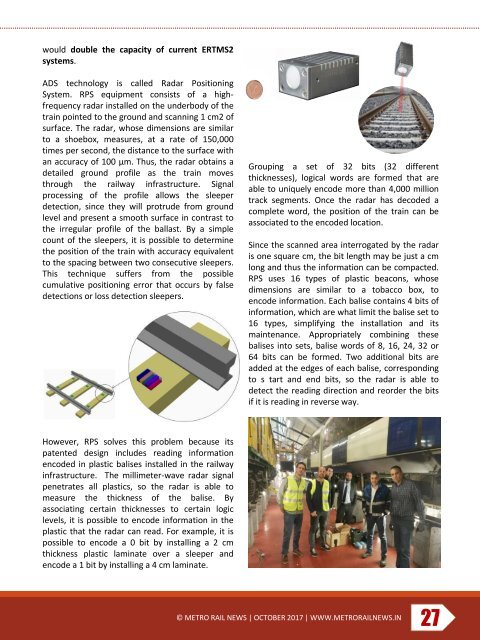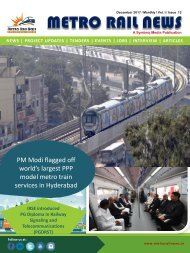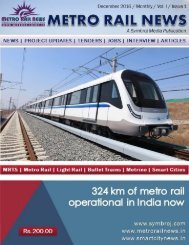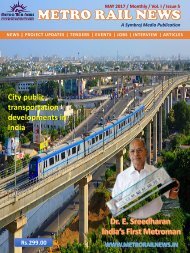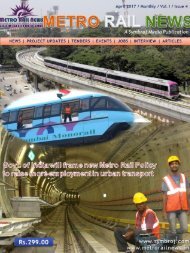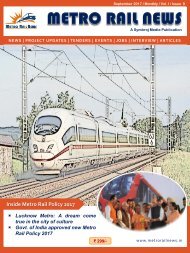Metro Rail News October 2017
October Edition 2017. Owned and published by Symbroj Media Pvt. Ltd., New Delhi, India
October Edition 2017. Owned and published by Symbroj Media Pvt. Ltd., New Delhi, India
Create successful ePaper yourself
Turn your PDF publications into a flip-book with our unique Google optimized e-Paper software.
would double the capacity of current ERTMS2<br />
systems.<br />
ADS technology is called Radar Positioning<br />
System. RPS equipment consists of a highfrequency<br />
radar installed on the underbody of the<br />
train pointed to the ground and scanning 1 cm2 of<br />
surface. The radar, whose dimensions are similar<br />
to a shoebox, measures, at a rate of 150,000<br />
times per second, the distance to the surface with<br />
an accuracy of 100 µm. Thus, the radar obtains a<br />
detailed ground profile as the train moves<br />
through the railway infrastructure. Signal<br />
processing of the profile allows the sleeper<br />
detection, since they will protrude from ground<br />
level and present a smooth surface in contrast to<br />
the irregular profile of the ballast. By a simple<br />
count of the sleepers, it is possible to determine<br />
the position of the train with accuracy equivalent<br />
to the spacing between two consecutive sleepers.<br />
This technique suffers from the possible<br />
cumulative positioning error that occurs by false<br />
detections or loss detection sleepers.<br />
Grouping a set of 32 bits (32 different<br />
thicknesses), logical words are formed that are<br />
able to uniquely encode more than 4,000 million<br />
track segments. Once the radar has decoded a<br />
complete word, the position of the train can be<br />
associated to the encoded location.<br />
Since the scanned area interrogated by the radar<br />
is one square cm, the bit length may be just a cm<br />
long and thus the information can be compacted.<br />
RPS uses 16 types of plastic beacons, whose<br />
dimensions are similar to a tobacco box, to<br />
encode information. Each balise contains 4 bits of<br />
information, which are what limit the balise set to<br />
16 types, simplifying the installation and its<br />
maintenance. Appropriately combining these<br />
balises into sets, balise words of 8, 16, 24, 32 or<br />
64 bits can be formed. Two additional bits are<br />
added at the edges of each balise, corresponding<br />
to s tart and end bits, so the radar is able to<br />
detect the reading direction and reorder the bits<br />
if it is reading in reverse way.<br />
However, RPS solves this problem because its<br />
patented design includes reading information<br />
encoded in plastic balises installed in the railway<br />
infrastructure. The millimeter-wave radar signal<br />
penetrates all plastics, so the radar is able to<br />
measure the thickness of the balise. By<br />
associating certain thicknesses to certain logic<br />
levels, it is possible to encode information in the<br />
plastic that the radar can read. For example, it is<br />
possible to encode a 0 bit by installing a 2 cm<br />
thickness plastic laminate over a sleeper and<br />
encode a 1 bit by installing a 4 cm laminate.<br />
© METRO RAIL NEWS | OCTOBER <strong>2017</strong> | WWW.METRORAILNEWS.IN<br />
27


